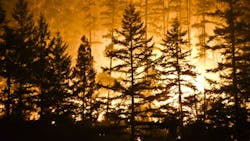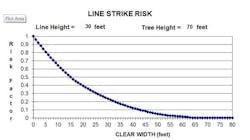Let’s re-cap. In your efforts to manage the risk of power-line initiated wildfires, you either have or are working on mapping wildfire risk across your service territory, adding further prioritization based on value at risk, escape routes, emergency response time, etc.
You have or are working on engineering solutions to reduce the risk of wildfire initiation by considering placement of reclosers, fuse types, use and placement of coated conductor and spacers and generally exploring all means of reducing the risk of arcing and burning metal falling to the ground.
Operationally you have determined equipment inspection frequency based on risk. You may have decided that in the highest fire-prone areas on code red days that reclosers will be set to single shot. You may have also decided that before re-energizing a line in the high fire risk areas after a prolonged outage that the whole line must be visually inspected to ensure it is free of any flammable materials or unintended fault paths.
We’ve already covered in a previous article the need to justify the frequency and intensity of hazard tree patrols. I’ve also addressed the need to have arborists collect further data for tree-caused outages and that what this will reveal is that generally, the majority of tree-caused outages arise from apparently healthy trees that the VM does not target. If that is the case and trees are most likely to fail and pose a fire risk on high wind days, how can you further reduce the risk of power line-initiated wildfires? It has been shown that tree-related outages are correlated to measures of system tree exposure. How do you reduce the tree exposure outside of undergrounding, which the customer wants only if the utility company shareholders, not ratepayers, pay for it? The options are decrease tree height, increase line height and/or increase clear width. I’m going to use clear width to illustrate the possibilities.
The graph below is based on a line height of 30 feet, adjacent trees that are 70 feet tall and a tree density of 250 trees per acre. This is pretty typical for a distribution system. If we also take a pretty typical distribution clear width of 12 feet between the tree trunks on the edge and the nearest conductor, the graph reveals that there is a 58% residual tree risk. Would it be a good idea to have a different right-of-way standard in the high fire risk areas? If you think so, you can see from the graph first, that there is a diminishing return in line security for dollars spent on increasing the clear width and secondly, that to eliminate 90% of the risk of a line contact on tree failure will require a clear width of 42 feet.
Such clearing would tremendously lower the number of trees capable of contacting the line on failure, proportionately reduce the number of hazard trees and reduce the area to inspect for hazard trees.
There are two drawbacks to this approach to reducing fire ignition risk. The first is that such widening would create a new and unstable edge. For a successful risk reduction it is necessary for reduction in tree exposure to have a greater impact on the probability of line contact than the impact of the increased failure rate along the new edge. Thus we are talking not about a little bit of widening but a lot of widening. The second problem that arises with attempting to get a much wider clear width is that it’s going to be resisted by landowners and the public in general. There may be some areas where the approach can be applied. If so, it would be important to carefully track tree-related outages in such areas as compared to the right of ways providing the standard 12 foot clear width. This will demonstrate what you would have achieved but for the objections of the public you serve.
I’ll just briefly mention that the other options of tree topping to about half the height (32 feet) or raising conductor height to reduce system tree exposure are more expensive and equally dramatic such that public resistance will impede implementation.
Such deliberations are not an exercise in futility. Rather, when adequately documented they will serve well as a defense should you have the misfortune of becoming a defendant in a wildfire suit. By exploring, quantifying and documenting every available option for reducing the risk of power line-initiated wildfires you will be positioned to clearly and directly answer the plaintiff lawyers’ questions. If the reason that you did not do more to decrease the risk is that ratepayers either wouldn’t fund or otherwise blocked your quantified risk reduction efforts, how can you be held responsible?
About the Author
Sig Guggenmoos
P. Ag. CPC President, Ecological Solutions Inc., Sherwood Park, Alberta, Canada
Education: Bachelor of Science in Agriculture B.Sc.(Agr.)
Accreditations: Professional Agrologist (P.Ag.); Certified Professional Consultant (CPC)
Organizations: Alberta Institute of Agrologists, International Society of Arboriculture, Utility Arborist Association, Industrial Vegetation Management Association of Alberta.
Mr. Guggenmoos was a chief architect of the TransAlta Utilities Distribution Line Clearance program, which reduced tree related outages 80%; saved 48 million dollars over two maintenance cycles; had a 98% customer satisfaction rating; and, showed a 21% increase in contractor crew productivity. He was responsible for the herbicide program, associated research and communication. In addition, he brought a financial focus to the program, developing processes for financial comparisons of alternatives to repetitive tree pruning and was intimately involved in the design and assessment of contracting methods.
As president of Ecological Solutions Inc. (Ecosync) Mr. Guggenmoos provides consulting services in vegetation management and biotic greenhouse gas mitigation strategies including biomass-derived energy.
Publications and Presentations:
Author of numerous abstracts and publications; numerous presentations to public, industry and professional associations including international conferences. List of publications available upon request.

